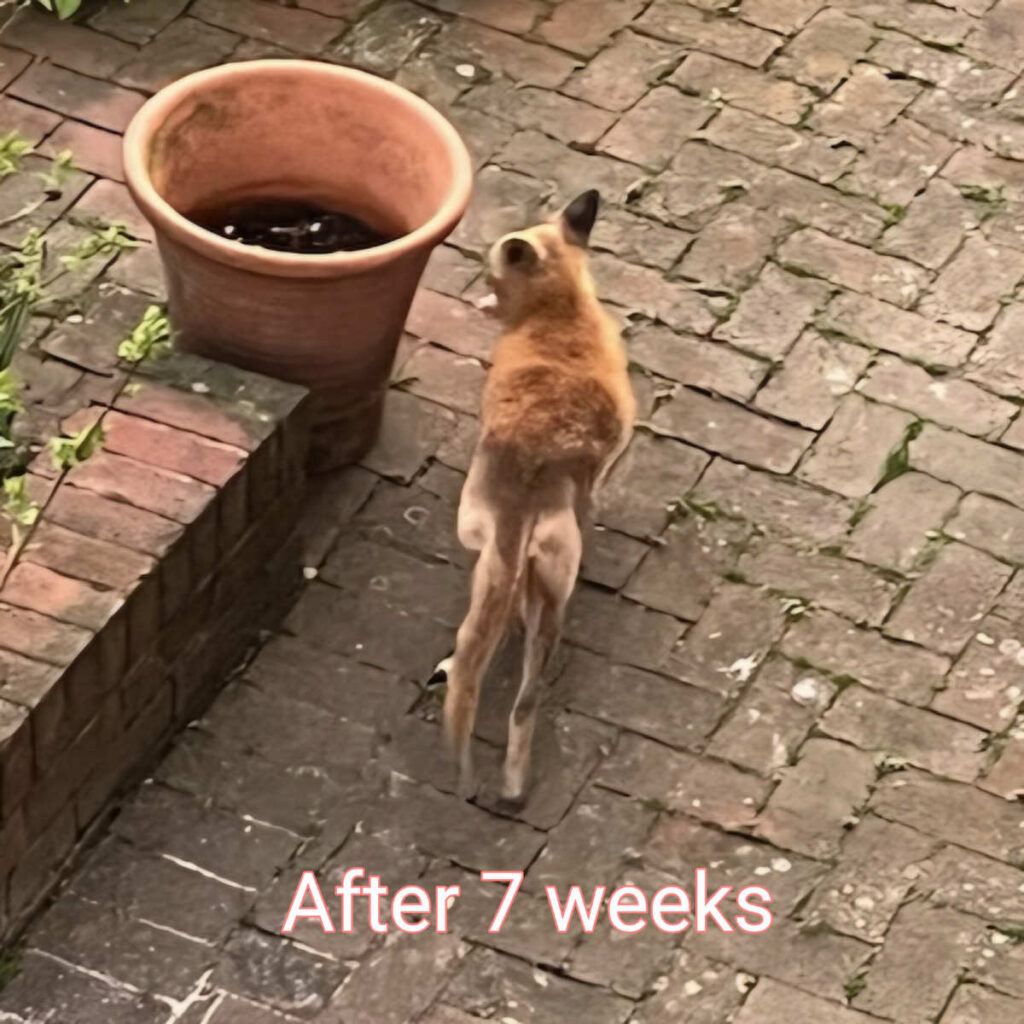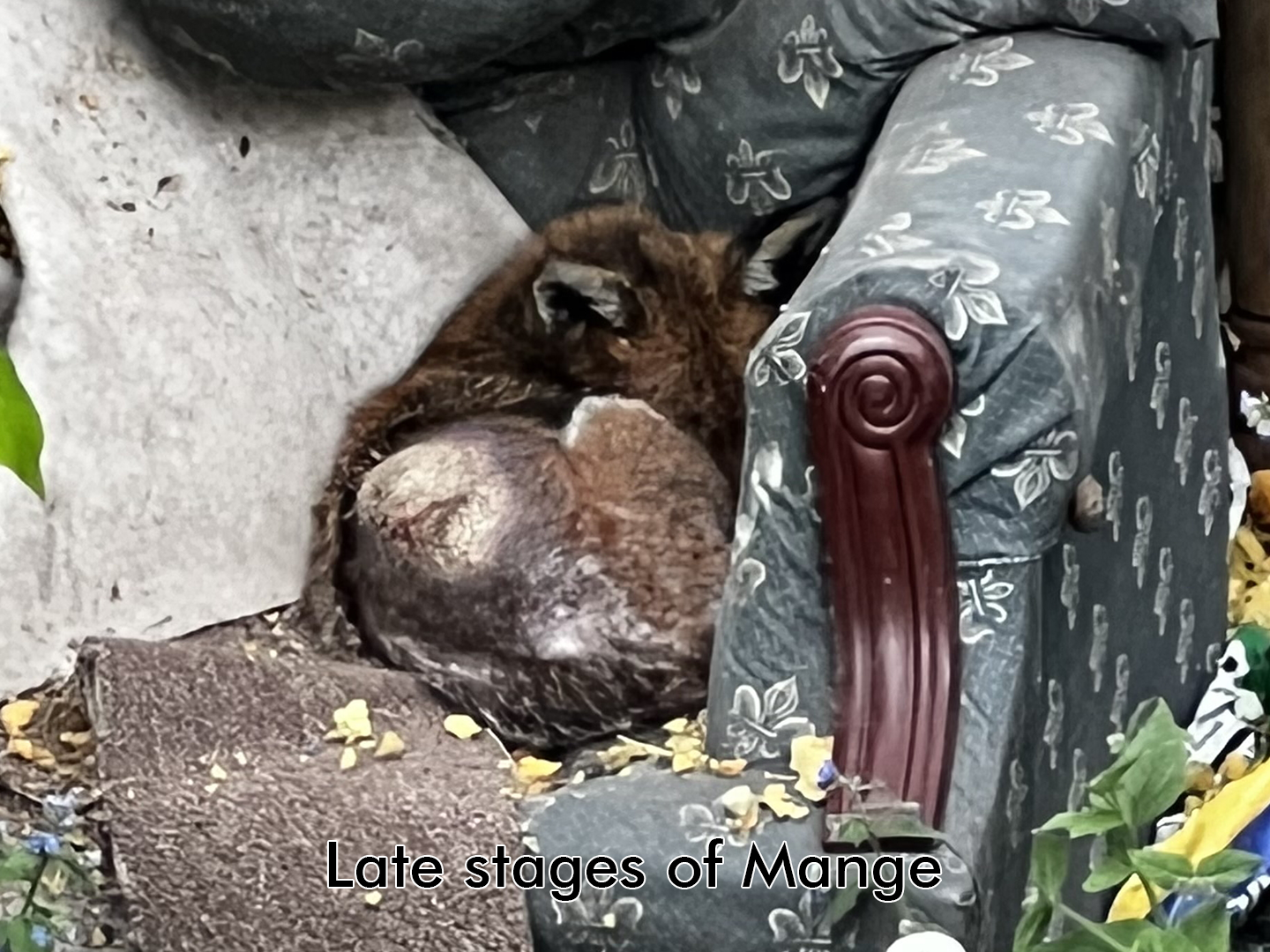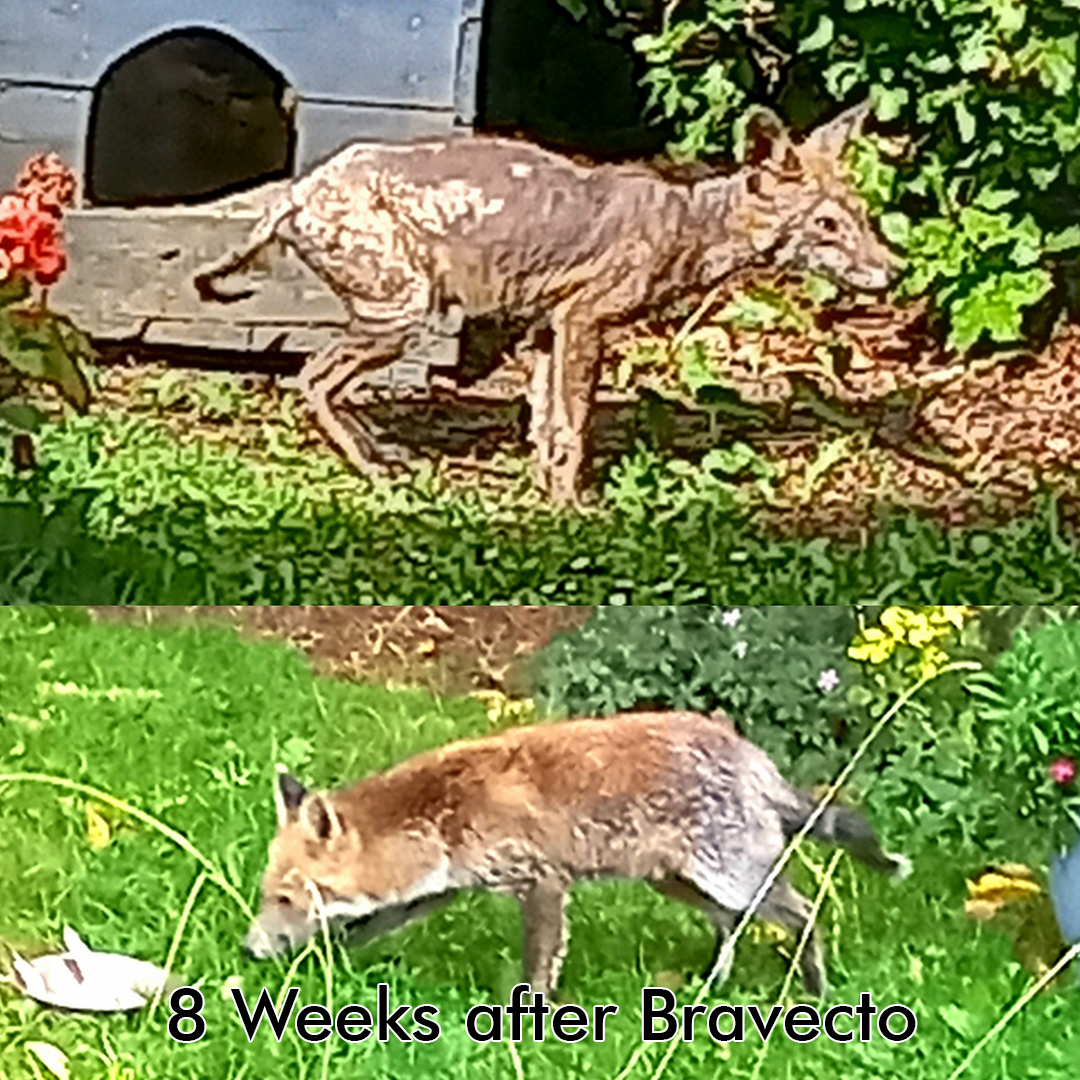
8 things you can do for a fox with mange
- Don’t look the other way – if mange does not get treated, it will eventually kill the fox.
- Take photos/a video, so your local wildlife rescue/vet can assess the state of the fox and establish if they may need rescuing.
- Establish a feeding pattern. Food is used as either a carrier for mange meds or bait in a trap, should the fox need trapping.
- Test multiple foods (raw chicken, a piece of cheese, a jam sandwich) to figure out which item the fox eats in front of you rather than carry off to a den or cache.
- The aim is that you can target-feed which means the fox will eat under supervision and can therefore be treated safely in the wild if trapping is no option.
- Provide fresh drinking water as mangy foxes are very dehydrated.
- Provide shelter from the elements. Mange leads to fur loss and the exposed skin may lead to hypothermia in winter and sunburn in summer.
- Get the full picture and read my in-depth info, explaining how to safely treat a fox in the wild and where to get the treatment from.
What Is Mange?
Sarcoptic mange is caused by parasitic mites burrowing under the skin. Most foxes carry mites but these parasites can multiply rapidly when a fox’s immune system is low. This will result in fur loss – usually starting at the brush and lower back, eventually spreading all over the body. If the fox is allergic to the mites’ excretions, the skin will go scabby (especially around the face and eyes). The skin gets even more aggravated by the fox scratching and biting the scabs, causing lesions that can get infected. The parasitic mite infestation will also dehydrate the fox and lead to weight loss. Sadly mange is NOT a self-limiting disease. This means if left untreated, it will eventually kill the fox either through dehydration, malnutrition and/or organ failure. Mange can be treated effectively with anti-parasite medication. The medication will kill the mites and their eggs, which enables most foxes to make a full recovery.
Note: there are some conditions that may look like mange but are NOT mange:
- Adult foxes are moulting in early summer and the shedding of the old winter coat will happen in large sections all over the body at the same time. When moulting, the new short coat re-growth is visible, rather than the naked and potentially inflamed or broken skin being exposed by mange. No treatment is required but you can support the fox growing a new coat by supplementary feeding.
- If a fox shows from one day to the next an isolated big patch of missing fur and red raw skin, this is usually a burn mark the fox obtained from resting up under a parked car that is still hot. This kind of wound will usually heal quickly and will not need anti-parasite treatment for mange.
“Moulting” image courtesy of Paul Winridge
How can you help a fox suffering from mange?
If you spot a fox with mange in your garden, you can help this fox by providing good quality food and setting up a regular feeding pattern. This is not only important to combat weight loss and support their immune system but also relevant for treating the sick fox. When treating a fox in the wild, food is used as the carrier for the mange medication and may also be used as bait inside a trap, should the fox need to be rescued. So, setting up a feeding pattern is the most important first step in helping a mangy fox. It is also crucial to supply fresh drinking water daily, as mangy foxes get very dehydrated and are in danger of kidney failure. To protect the fox from the elements you can provide an outdoor shelter like a small dog kennel or a box filled with straw – this may prevent hypothermia in winter and sunburn in summer. Get more info on what makes a good fox shelter here.
If you have a feeding pattern in place, the fox is happy to eat under your supervision and you have been able to get hold of anti-parasite treatment, it is usually straightforward to treat a mangy fox in the wild. If there are no underlying health conditions, one dose of the most efficient anti-parasite treatment Bravecto (for a dog 4.5-10 kilos) can cure the mange without putting the animal through the stress of being trapped and handled by humans.
In some cases, a fox suffering from advanced mange as well as other underlying health issues or a bad injury on top of the mange – may need to be trapped so they can be treated and rehabilitated at a rescue centre. These foxes are usually being re-released into the wild a few weeks later. However, Professor Dawn Scott, the UK’s leading fox expert educated us that trapping and captivity is very stressful for a wild fox and should only be used as a last resort when the animal can’t be treated in the wild.
How to get the anti-parasite treatment
Your first port of call will be your local wildlife rescue-in the UK; you can find them here or contact your neighbourhood veterinarian. To get the help of a wildlife rescue organisation or vet it is essential to record some photo or video evidence of the sick fox. These visuals will be assessed to determine how advanced the mange is, if there may be other health conditions and to decide how to best treat this fox. If you can prove that you have a feeding pattern in place and can target-feed the sick fox, you may be able to get the mange treatment so you can treat the fox in the wild. Mange can be treated by the same anti-parasite medication given to dogs. An average adult foxes weighs between 4-7 kilos.
Nexguard (for small dog 3.5 – 7.6 kilos) and Bravecto (for a small dog 4.5-10 kilos) are effective treatments.
Sadly, it can be extremely difficult to get hold of this anti-parasite treatment, depending on where you live. This has to do with the fact that in the UK the treatments for mange are currently still prescription-only drugs. Officially a vet needs to assess an animal on their table to prescribe the treatment. However, this is completely impractical when it comes to helping the many wild foxes that suffer from mange. There simply are not enough traps and rescuers available in most parts of the country to trap the many foxes suffering from mange and get them taken to a vet. Also, trapping is NOT advised during winter (mating season) and spring (when cubs are being reared). Last but not least, it can take weeks to trap a wild fox and if the fox suffers from advanced mange, it may die before it can be trapped.
Only a few vets think beyond the red tape and prescribe anti-parasite treatment for a fox they assessed remotely based on visual evidence only. It completely depends on your vet’s attitude towards saving wildlife how they may respond and if they are willing to help by enabling a responsible person to treat a fox in the wild.
Some vets donate slightly ‘out of date’ anti-parasite treatments and other medication to wildlife rescuers. The rescuers will then pass the treatment on to people who are able to target-feed ‘their’ sick fox medicated food. Rescuers have to be very discreet about this and do not advertise this service, and it is hit and miss what treatments (if any) they have available when you enquire. If you do not hear back, contact them repeatedly until you get a reply. A rescue organisation may provide you with the treatment needed, however it will be down to you to invest the time needed to safely treat a fox in the wild. The same is true for supervising a baited trap. This would be your responsibility.
Shockingly many vets and even so-called “rescue” organisations turn a blind eye when it comes to saving fox lives – often the phrase used is “nature is cruel”, suggesting that we should ‘not interfere and let nature do its thing’ and let a fox suffering from mange die a horrible, drawn-out death. I have been told this again and again in the many calls for help Fox Guardians has received. People who contact us have often exhausted all other options and the fox is near death by the time they contact us for advice.
Over the years I have witnessed so much suffering of foxes and it saddens me greatly that there is so much red tape around mange medication. Precious fox lives are being lost because rescuers may not be available in the area the sick fox lives in, or they lack the resources to treat or trap a sick fox. I believe it is our duty as humans not to look the other way but always show compassion towards any suffering animal. If just one pill can save this animal’s life, then this animal should be given that ‘magic pill’ (just ONE dosage of Bravecto for a 4.5-10 kg dog can cure mange and keep a fox mange-free for 3 months), so they have a fighting chance of survival. Nexguard is another excellent mange treatment and has the advantage that it also de-worms the animal. For most foxes you would give a dosage for a dog 3.5 up to 7.5 kilos. One dosage may be sufficient to cure mange, however a follow-up treatment after a month is usually advised. But sometimes it may not possible to administer this second treatment. Fox movements can be erratic, especially during mating season and sometimes foxes go off the radar once they start to feel better.
Of course, the treatment administration needs to happen in a responsible manner.
This means having a feeding pattern in place and being able to supervise the feed to make sure the fox takes the treatment. You cannot just leave the medicated food outside unsupervised as it may harm other wildlife such as a bird or hedgehog. Note: It can be very time-consuming to treat the wild fox responsibly and in some cases A LOT of patience is required. I once had to do 12 night watches in the small hours until I successfully treated a very elusive fox that was suffering from late stage mange and visited my garden only every few nights, usually around 4 am. But nothing beats that feeling when you witness a sick fox eat the medicated food and you know that they have a chance to fully recover. It is understandable that the dispensation of antibiotics and opioids is highly restricted but anti-parasite treatments fall into a different category. Many pet parents give their dogs and cats routinely anti-parasite treatment as a preventative measure. This is why in many countries around the world ‘Bravecto’ is sold over the counter with no restrictions. It is possible to buy anti-parasite treatments like Bravecto and Nexguard online from these countries. The recommended dosage for an average size fox is equivalent to the dosage for a small dog – 4.5-10 kg for Bravecto and 2.75-7.5 kg for Nexguard.
I buy my treatments here. Note: this merchant has NO affiliation with Fox Guardians. The treatments take 2-3 weeks to arrive. You must make sure you get the “chews”, NOT the spot-on treatment and for Bravecto buy the more expensive version that provides 3 months protection from mange. Make sure you buy the right dosage for a fox (Bravecto: orange circle around the dog, 4.5-10 kilos) or (Nexguard: yellow circle around the dog, 3.5-7.5 kilos). It does NOT work to split up bigger dosages due to the way the treatments are manufactured. Please make sure you read my info below on how to safely give this treatment so no other wildlife may be harmed and that the fox gets the full dosage needed.
Top Tips – How To Treat a Fox in the Wild:
I cannot reiterate enough that it is not safe to leave medicated food outside unattended. You have no control over which animal will take the treatment that could cause harm to other wildlife or a pet. If you have been able to get hold of a treatment, you MUST put in the hours needed to target-feed and act responsibly.
Even though Bravecto and Nexguard are sold as a “chew” (at the size of an aspirin pill), a fox would not just eat the chew by itself. Many rescue organisations advise giving the treatment inside a “jam sandwich”. In my experience this is not the best option. Given as a whole, the pill would fall out. I chop up the pill into fine powder, mix it with a tiny amount of wet dog food (the tip of a knife) to make a ‘pate’ that will then be inserted into the carrier food.

The key is to identify the food the fox will eat in front of you, rather than carry off to the den or cache. So do determine the right food first before choosing the carrier for the meds by offering the fox multiple different foods that are not loaded with treatment.
It is also crucial to only give a bite-sized piece of food when treating the fox to make sure they get the whole dosage. So, one bite-sized piece of chicken or cheese or the centre of a doughnut or a spoon full of wet dig food. You always can give a full feed to the fox once they had their treatment.
I have had very good experiences when inserting the ‘pate’ into a piece of fresh chicken that I cut a slit into. Mild cheddar also works well for foxes that like it – I add the powder into a piece of melted cheese that I then fold over into a bite sized cube and let it set in the fridge.
The cheese cube can be thrown without breaking which is useful when treating an animal that does not come close. I have used this method with shy foxes, throwing them the medicated cheese cube whist observing them from inside a hide or a darkened room. The advantage of the cheese cube is that it will keep in the fridge many days and you got multiple chances of feeding it to the fox, unlike treated wet dog food. You can also use “pill pillows” for dogs that wrap around a chew which you could do on sight of a fox in a few seconds, however I found that not all foxes identify the pill pillow as food and even if they do eat it bits of the hard chew may fall out so it would be hard to gauge if a fox has a whole dosage.
The core of a jam-filled doughnut works well for foxes that have a sweet tooth. Test these carrier food options first to figure out which option the fox prefers and eats on the spot. When treating a fox, only give a medicated bite-sized morsel to make sure the full treatment is taken, rather than carried off to be cached. You can give a full feed afterwards.
It will be challenging to treat a fox parent during cubbing season, as the parents usually carry all solid food back to the den to feed the cubs. When dealing with this scenario, you could crumble the chew, add a tiny bit of hot water to make a paste and stir this into a raw scrambled egg that the fox cannot carry off and will lick up and ingest. This method worked for me when treating a vixen that gave ALL other food to her cubs in the den.
When treating a fox in the wild, the ideal scenario is to help a fox that trusts you enough to eat food near you, under your supervision. If the fox is too shy to come close and does not trust you, you need to observe them from a darkened room or a hide, throwing the food to them from a distance when they appear. I usually do this in the moment the fox has turned their back to me so I don’t spook them. It also helps when there is a noise such as a car going by or a gust of wind as these sounds will mask the sound of you throwing the medicated food.
Please ask someone experienced in helping foxes in the wild on how best to treat. If there is a local rescue, you should also inform them that an animal has been treated and provide them with a picture to avoid the same animal being treated twice. I provide the local rescue with pictures and a bio of foxes on my radar, so they can add this info to their spreadsheet and we regularly share updates on the wellbeing of the foxes, if they have been treated or may need trapping.
I hope you find this information based on my personal experiences useful and are able to help the fox you are supporting. We hope the pictures below give you hope. They feature Del Boy who was extremely ill with advanced mange, as well as being underweight and suffering from open wounds. He should have been trapped to be treated, and rehabilitated but as this was not possible, he was treated in the wild with Bravecto and also fed every night. In the wild. Against all odds, he did not only survive but is thriving right now.













